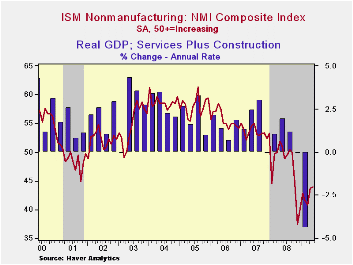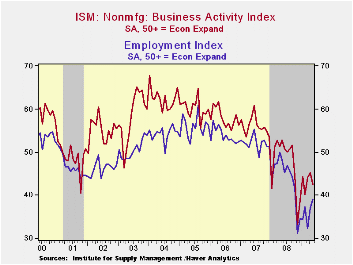 Global| Jun 03 2009
Global| Jun 03 2009U.S. ISM Nonmanufacturing Index Improves Further
by:Tom Moeller
|in:Economy in Brief
Summary
Improvement in service sector activity is accompanying the factory sector's recent rise. The May Composite Index for the nonmanufacturing sector from the Institute for Supply Management (ISM) rose to 44.0 last month from an unrevised [...]

Improvement in service sector activity is accompanying the factory sector's recent rise. The May Composite Index for the nonmanufacturing sector from the Institute for Supply Management (ISM) rose to 44.0 last month from an unrevised reading of 43.7 during April. The latest was the highest level since October of last year but it was slightly lower than Consensus expectations for a May reading of 45.0. A level of the ISM index below 50 indicates declining activity. Since the series' inception in 1997 there has been a 60% correlation between the level of the business activity index in the nonmanufacturing sector and the Q/Q change in real GDP for the services and the construction sectors.
That latest rise came as the employment index rose to its highest level since October. Since the series' inception in 1997 there has been a 56% correlation between the level of the ISM nonmanufacturing employment index and the m/m change in payroll employment in the service-producing plus the construction industries.Also to the upside was the supplier deliveries index. 
Countering these gains were declines in the business activity sub-index after two months of improvement. The new orders series also fell but just slightly. At 44.4 it remained well up from last November's low of 35.6.
Pricing power has shown moderate improvement this year in that earlier declines have not continued. The price index has been relatively stable in a range of 36 to 48 after reaching a high of 82.1 last Spring. Since its inception ten years ago, there has been a 60% correlation between the price index and the q/q change in the GDP services chain price index.Beginning with the January 2008 Nonmanufacturing Report On Business®, the composite index is calculated as an indicator of the overall economic condition for the non-manufacturing sector. It is a composite index based on the diffusion indices for four of the indicators (business activity, new orders, employment and supplier deliveries) with equal weights. The latest report from the ISM can be found here.
ISM surveys more than 370 purchasing managers in more than 62 industries including law firms, hospitals, government and retailers. The nonmanufacturing survey dates back to July 1997.
| ISM Nonmanufacturing Survey | May | April | May '08 | 2008 | 2007 | 2006 |
|---|---|---|---|---|---|---|
| Composite Index | 44.0 | 43.7 | 51.2 | 47.4 | 53.5 | 55.7 |
| Business Activity | 42.4 | 45.2 | 52.9 | 47.4 | 56.0 | 58.0 |
| Employment | 39.0 | 37.0 | 48.3 | 43.8 | 52.0 | 53.8 |
| Prices Index | 46.9 | 40.0 | 75.6 | 66.0 | 63.8 | 65.3 |
Tom Moeller
AuthorMore in Author Profile »Prior to joining Haver Analytics in 2000, Mr. Moeller worked as the Economist at Chancellor Capital Management from 1985 to 1999. There, he developed comprehensive economic forecasts and interpreted economic data for equity and fixed income portfolio managers. Also at Chancellor, Mr. Moeller worked as an equity analyst and was responsible for researching and rating companies in the economically sensitive automobile and housing industries for investment in Chancellor’s equity portfolio. Prior to joining Chancellor, Mr. Moeller was an Economist at Citibank from 1979 to 1984. He also analyzed pricing behavior in the metals industry for the Council on Wage and Price Stability in Washington, D.C. In 1999, Mr. Moeller received the award for most accurate forecast from the Forecasters' Club of New York. From 1990 to 1992 he was President of the New York Association for Business Economists. Mr. Moeller earned an M.B.A. in Finance from Fordham University, where he graduated in 1987. He holds a Bachelor of Arts in Economics from George Washington University.






